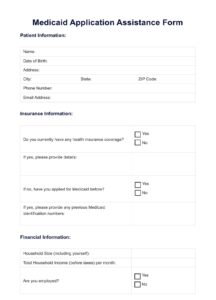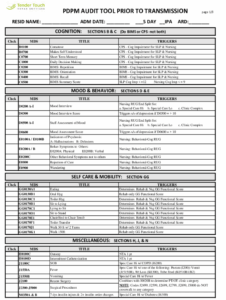Navigating the world of home health care can feel overwhelming, especially when you’re dealing with the intricacies of speech and language therapy. One of the biggest challenges faced by therapists and agencies alike is maintaining thorough, accurate, and efficient documentation. After all, clear documentation is essential for proper patient care, effective communication with other healthcare professionals, and successful reimbursement.
That’s where the concept of templates comes into play. Standardized templates for speech and language therapy documentation in the home health setting can significantly streamline the process, ensuring that all necessary information is captured consistently and accurately. This not only saves time but also reduces the risk of errors or omissions, ultimately leading to better patient outcomes.
But finding or creating the right templates can be daunting. What information needs to be included? How can you tailor the templates to meet the specific needs of your patients and your agency? And how can you ensure that your documentation is compliant with all relevant regulations? This article will explore these questions and offer practical guidance on utilizing effective home health speech and language template documentation.
Why Accurate Speech and Language Documentation is Critical in Home Health
In the dynamic world of home health, where therapists often work independently and communicate remotely, accurate and comprehensive documentation is more than just good practice – it’s essential. Think of your documentation as the bridge connecting you, the patient, other healthcare providers, and the payers. It’s the foundation for collaborative care, informed decision-making, and justified reimbursement. Without a strong, well-maintained bridge, things can easily fall apart.
Consider this: your documentation serves as a legal record of the services you provided, the patient’s progress (or lack thereof), and the rationale behind your treatment plan. This record can be critical in the event of an audit, a legal dispute, or a transfer of care to another provider. A thorough and well-organized record demonstrates your commitment to quality care and protects you from potential liabilities. If an auditor comes knocking, your documentation will be your shield.
Furthermore, detailed documentation facilitates effective communication with other members of the healthcare team, including physicians, nurses, occupational therapists, and physical therapists. By clearly articulating your assessment findings, treatment goals, and progress notes, you enable everyone involved in the patient’s care to work together seamlessly. This collaborative approach leads to better coordinated care and improved patient outcomes. It’s about getting everyone on the same page so the patient benefits the most.
Moreover, proper home health speech and language template documentation allows for tracking progress over time. Using consistent templates helps in objectively measuring a patient’s gains or setbacks, ensuring that interventions are effective and targeted. This data is crucial for adjusting treatment plans, setting realistic goals, and demonstrating the value of speech and language therapy in improving the patient’s quality of life. Seeing quantifiable improvement can be incredibly motivating for both the therapist and the patient.
Finally, and let’s be honest, very importantly for home health agencies, accurate documentation is crucial for securing reimbursement from Medicare, Medicaid, and private insurance companies. These payers require detailed information about the services provided, the patient’s medical necessity for those services, and the progress being made toward established goals. Incomplete or inaccurate documentation can lead to claim denials, delays in payment, and even potential penalties. Think of accurate documentation as your ticket to getting paid for the work you do. Without it, that ticket is worthless.
Key Elements of Effective Home Health Speech and Language Template Documentation
Creating effective home health speech and language template documentation doesn’t have to be a Herculean task. By focusing on a few key elements, you can develop templates that are both comprehensive and user-friendly. The goal is to create a system that captures all the necessary information without becoming overly burdensome or time-consuming.
First and foremost, your templates should include a clear and concise patient identification section. This section should include the patient’s name, date of birth, medical record number, and other relevant demographic information. Accuracy is paramount here, as even a small error can lead to confusion and potential medical errors. Double-check, triple-check, and make sure it’s right.
Next, your templates should incorporate a comprehensive assessment section. This section should include a detailed description of the patient’s speech, language, cognitive, and swallowing abilities, as well as any relevant medical history and current medications. Be sure to include standardized assessment tools and objective measures whenever possible. This section should paint a clear picture of the patient’s current functional status and identify any areas of impairment. Think of this as your baseline – where the patient is starting from.
The templates should also include a section for establishing measurable and achievable goals. These goals should be specific, measurable, achievable, relevant, and time-bound (SMART). They should also be aligned with the patient’s needs, preferences, and functional abilities. Clear and well-defined goals provide a roadmap for therapy and allow you to track progress effectively. What specific improvements are you hoping to see?
Progress notes are another crucial component of your documentation. Each progress note should include a brief summary of the therapy session, the patient’s response to treatment, and any changes to the treatment plan. Be sure to document any adverse events or complications that occur during the session. Progress notes should be written clearly, concisely, and objectively. This is your opportunity to demonstrate the value of your services and justify continued therapy.
Finally, your templates should include a discharge summary. This summary should provide an overview of the patient’s progress throughout therapy, the goals that were achieved, and any recommendations for continued care. It should also include a plan for transitioning the patient back to their prior level of function, if possible. The discharge summary serves as a final record of the services provided and helps to ensure a smooth transition for the patient. Think of this as the final chapter in the patient’s therapy journey. Creating and using the right home health speech and language template documentation will make you a more efficient and effective therapist.
Good documentation makes for good communication and a clear record of patient progress. It’s an essential part of providing quality care.
By prioritizing clear and consistent documentation, therapists can ensure the best possible outcomes for their patients and protect themselves and their agencies.



